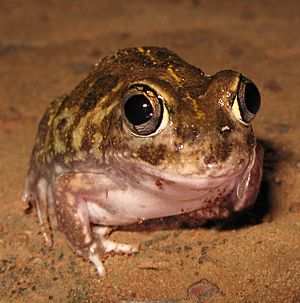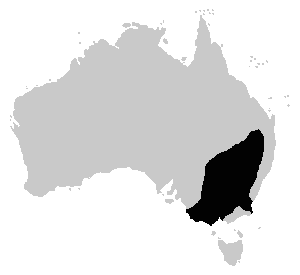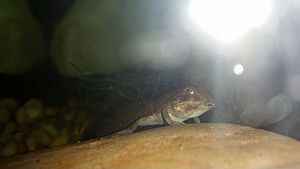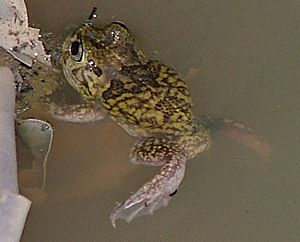Sudell's frog facts for kids
Quick facts for kids Sudell's frog |
|
|---|---|
 |
|
| Conservation status | |
| Scientific classification | |
| Genus: |
Neobatrachus
|
| Species: |
sudellae
|
 |
|
| Range of the Sudell's frog | |
The Sudell's frog is also known by other names like the painted burrowing frog or trilling frog. Its scientific name is Neobatrachus sudellae. This amazing frog is common in many parts of southeastern Australia. You can find it west of the Great Dividing Range in New South Wales, Victoria, southern Queensland, and eastern South Australia.
Contents
About the Sudell's Frog
The Sudell's frog is quite small, usually growing up to about 40 millimeters (about 1.5 inches) long. Its color can vary a lot! It's often brown, but some can be grey, yellow, or even reddish. They usually have darker spots or blotches on their back.
Many Sudell's frogs have a pale stripe running down the middle of their back. Their belly is smooth and a light cream or white color. Their toes are fully webbed, which helps them swim. However, there's a deep dip between each webbed toe.
These frogs have a special shovel-like part on their foot called a metatarsal tubercle. This part is completely black and helps them dig into the ground. Their eyes have a vertical pupil, like a cat's, and their iris (the colored part) is silver.
Where Sudell's Frogs Live
The Sudell's frog lives in many different places. You can find them near ponds, dams, ditches, or even in clay pans. They like still water in woodlands, shrublands, and even in areas changed by humans, like farms.
These frogs are very good at living in dry places. They can handle arid (very dry) environments well. The frogs commonly called "Sudell's frog" are found more in the eastern parts of Australia.
How Sudell's Frogs Behave
Sudell's frogs are excellent burrowers. This means they can dig themselves underground. They often spend a lot of time buried to escape dry conditions or droughts.
After heavy rains, especially from late winter to autumn, males will float in the water. They make a short trilling sound to attract mates. This is why they are sometimes called "trilling frogs"!
Reproduction and Life Cycle
Female Sudell's frogs lay about 600 eggs in a clump. They usually place these eggs among plants near the water's surface. If the eggs are disturbed, they might sink.
The eggs hatch into tadpoles in about three days. These tadpoles are plump and can grow quite large, up to 77 millimeters (about 3 inches). Sometimes, the tadpoles will stay in their tadpole stage through the winter. When they change into adult frogs, they are usually about 20 to 30 millimeters long.
Surviving in the Desert
Trilling frogs are specially adapted to desert life. They can stay buried deep underground for years without coming to the surface! They have glands under their skin that can store water.
When the late summer rains begin, these frogs will often dig their way to the surface. They spend a few weeks calling every night. They float in or sit at the edge of puddles, claypans, and waterholes filled with rainwater.
They eat the many insects that appear after the rains. They lay their eggs in long clumps, often wrapped around things in the water. Their tadpoles grow up very quickly.
Like most Australian frogs, the trilling frog is a predator. This means they hunt and eat other animals. Their diet mostly includes any desert insects and small reptiles that can fit into their mouth. In some areas, they are the only ground-living animal of their size that can be found.
Similar Frogs
The Sudell's frog looks similar to other frogs in the Neobatrachus group. It's especially similar to the painted burrowing frog (Neobatrachus pictus). You can tell them apart because the Sudell's frog has loose, "baggy pants" skin around its groin area, which the painted burrowing frog does not have.
It also looks a bit like the ornate burrowing frog (Platyplectrum ornatum) and frogs from the Heleioporus group. You can tell the Sudell's frog apart by its completely black metatarsal (the shovel-like part on its foot), its webbed toes, and its vertical pupil.
Interesting Facts About Their Genes
This little frog is quite special because it is a tetraploid organism. This means it has double the normal number of chromosomes (the tiny structures in cells that carry genetic information). Scientists used to think the Neobatrachus centralis was a different species, but genetic studies showed it's actually the same as the Sudell's frog.
Sudell's Frogs as Pets
Some people keep Sudell's frogs as pets. In Australia, you need a special permit to keep this animal in captivity.
Images for kids
See also
 In Spanish: Neobatrachus sudelli para niños
In Spanish: Neobatrachus sudelli para niños






